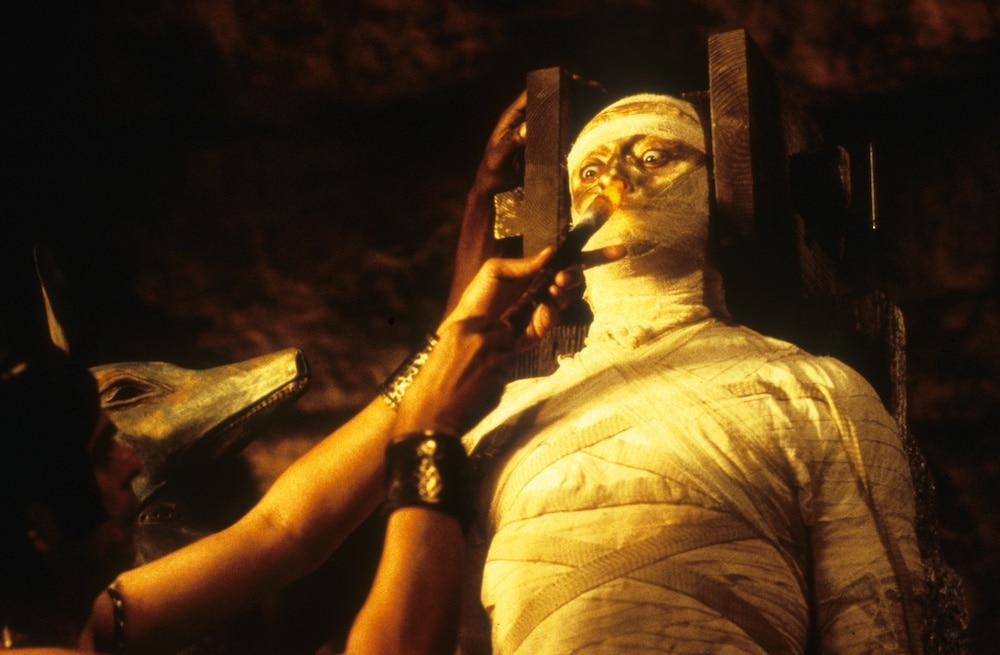Create a free profile to get unlimited access to exclusive videos, sweepstakes, and more!
How Mummification Works: The Real-World Science Explained
Ancient Egyptian practitioners were masters of post-mortem preservation.

Brendan Fraser’s 1999 Egyptian adventure, The Mummy, (now streaming on Peacock), is arguably the best among a crowded field of mummified movie monsters. It marries the now-classic tropes of the genre with the charm and chemistry of Fraser and Rachel Weisz.
The titular mummy is named Imhotep, a traitor to the throne who undergoes a somewhat unconventional mummification technique. Captured by the Pharaoh's forces, Imhotep is sentenced to endure the Hom-Dai, a curse which will sustain him in an eternal living death. He is wrapped alive, bound in linen, and entombed in a sarcophagus with hundreds of flesh-eating scarabs.
If the Pharaoh’s priests actually wanted to preserve Imhotep’s body for the ages, they skipped a couple of important steps. Whether your mummies are old (The Mummy’s Curse), animated (The Mummy: The Animated Series), or friendly (Hotel Transylvania), they all went through more or less the same mummification process. Here’s how mummies get made.
How the Ancient Egyptians Made Mummies
The key element of mummification is the removal of moisture, to prevent the worst ravages of decay. Egyptians mummified their dead so that bodies could be preserved and utilized in the afterlife. There was an intention and a cultural weight which accompanied and influenced the process.
The Egyptian mummies have become so famous and so beloved around the world because they can tell us so much about the people who made them. This is in contrast to natural mummification which happens accidentally in especially arid or cold places, or in the anoxic environments inside bogs. Even among the ancient Egyptian cultures, there were various forms of mummification, just as there are various forms of post-mortem preservation today. What level of mummification a person received, often had a lot to do with their social or economic status.
The most effective process, and the one used on the most famous Egyptian mummies, dates back to more than 5,000 years ago and took up to 70 days to complete. Practitioners were skilled in the preservation of the dead, and also in the various spiritual practices which accompanied mummification.
First, the body was washed with a combination of wine and spices, then the organs were removed. Organs hold a lot of moisture and removing them is a quick and easy way to slow the process of decomposition. The brain was removed with a hooked implement pushed through the nostrils and into the brain cavity. At the time, people didn’t understand the importance of the brain and believed the heart to be the seat of being. It was the only organ left intact. The rest of the organs were removed and stored in canopic jars. In some cases, the organs were removed, treated, wrapped, and placed back inside the body cavity.
Next, the body was treated with natron, a naturally occurring carbonate salt found along salt lakes and in dry lake beds. Its moisture-wicking properties made it a useful cleanser and a top-notch preservative. Sure, the Egyptian mummies look a little worse for wear, but they’ve remained relatively shelf-stable for 5,000 years.
Packets of natron were stuffed inside the body cavity and the rest of the body was coated and left to dry for 40 days. Once dry, the body was wrapped in hundreds of yards of linen and warm resin. The resin-coated linen acts as a final shield to protect the body from the elements. In the end, the body has been preserved inside and out. The Egyptian mummies have endured in their resting places for thousands of years and will continue to do so for thousands more, unless some adventurer wakes them from their slumber.
The Mummy (1999) is streaming on Peacock, and it’s not alone. If you want even more linen-wrapped adventures, catch The Mummy Returns, The Mummy (2017), and more!
























